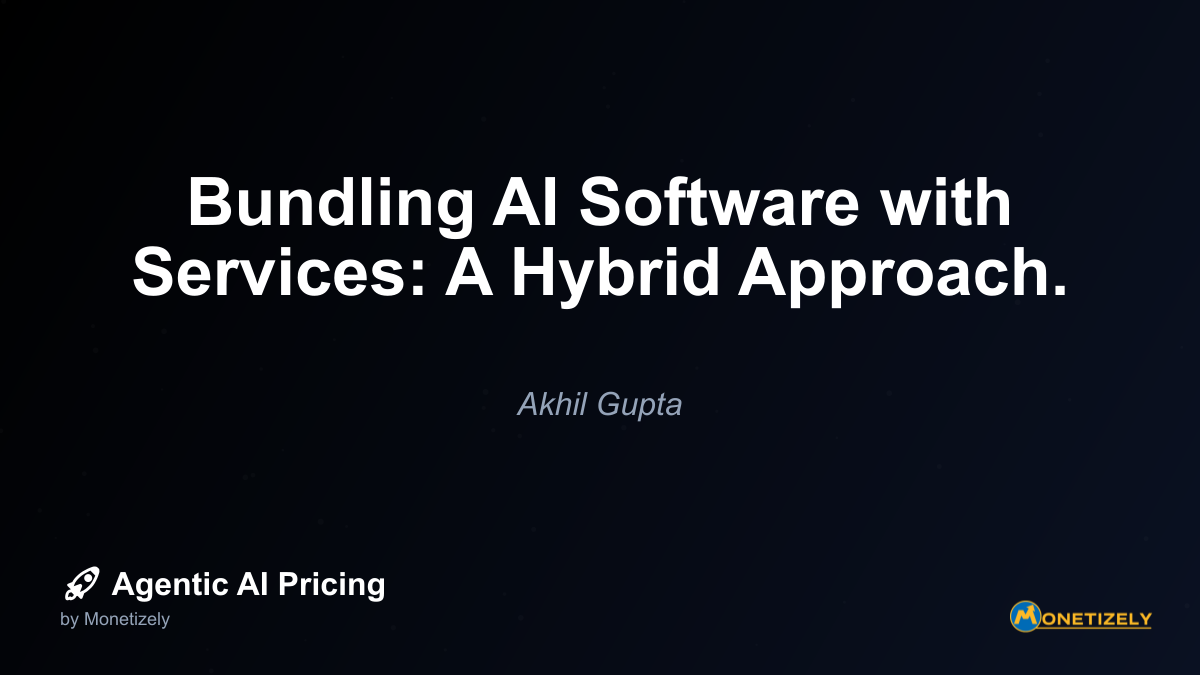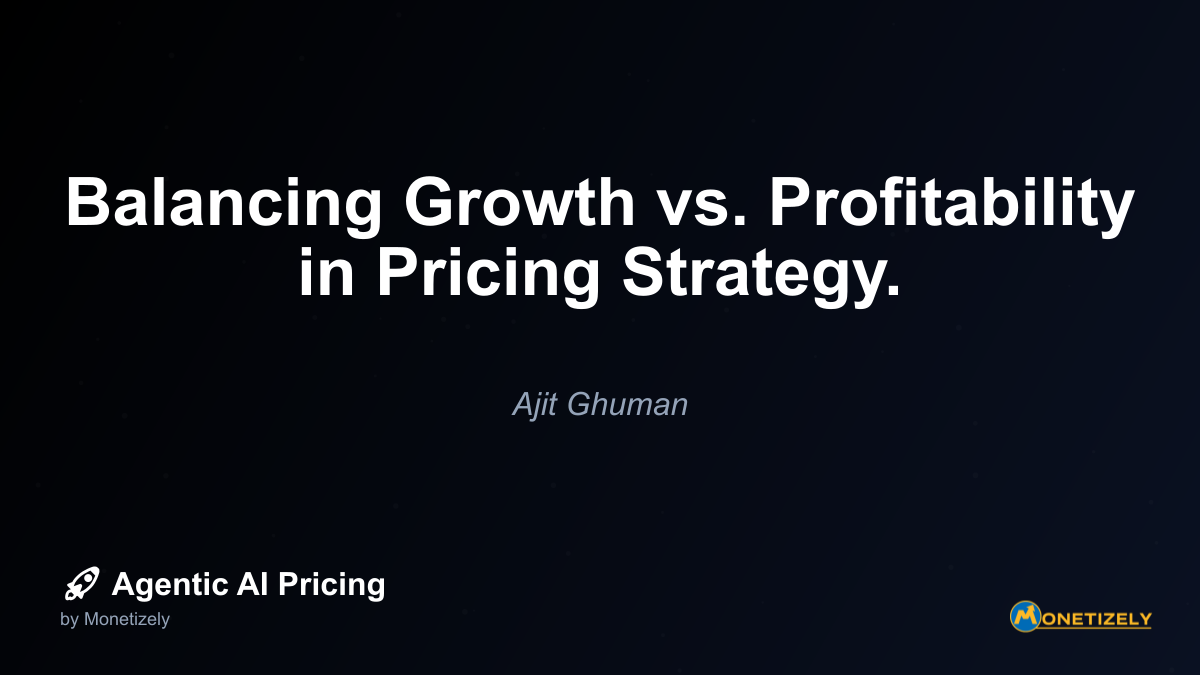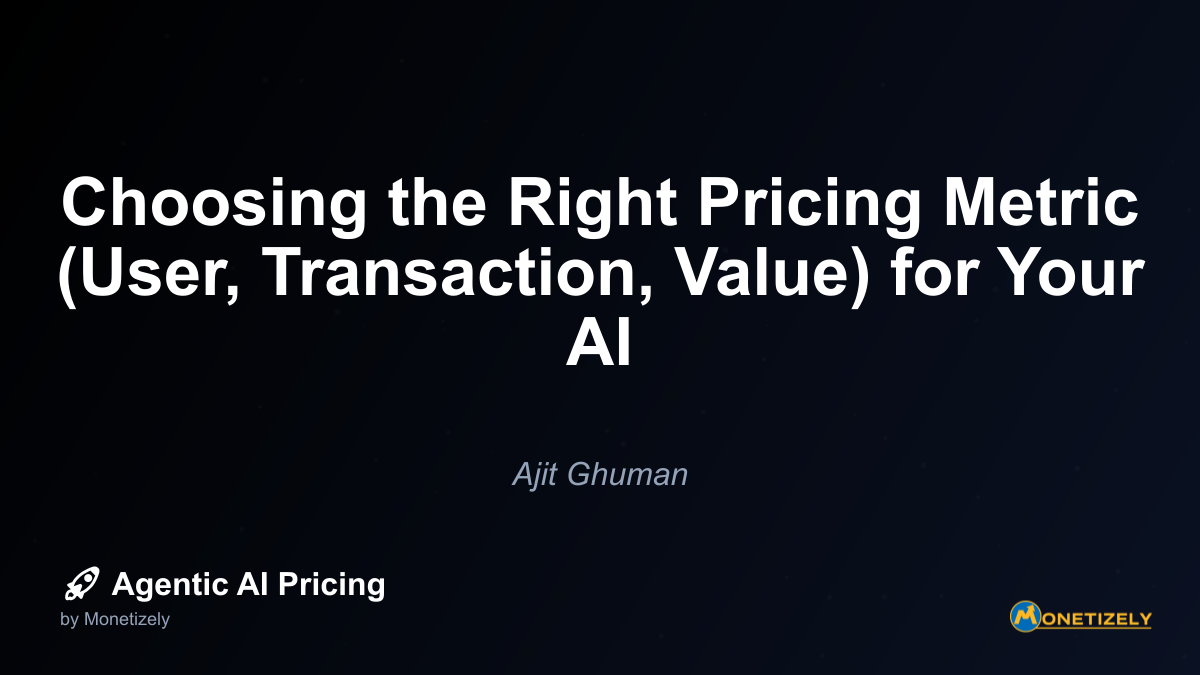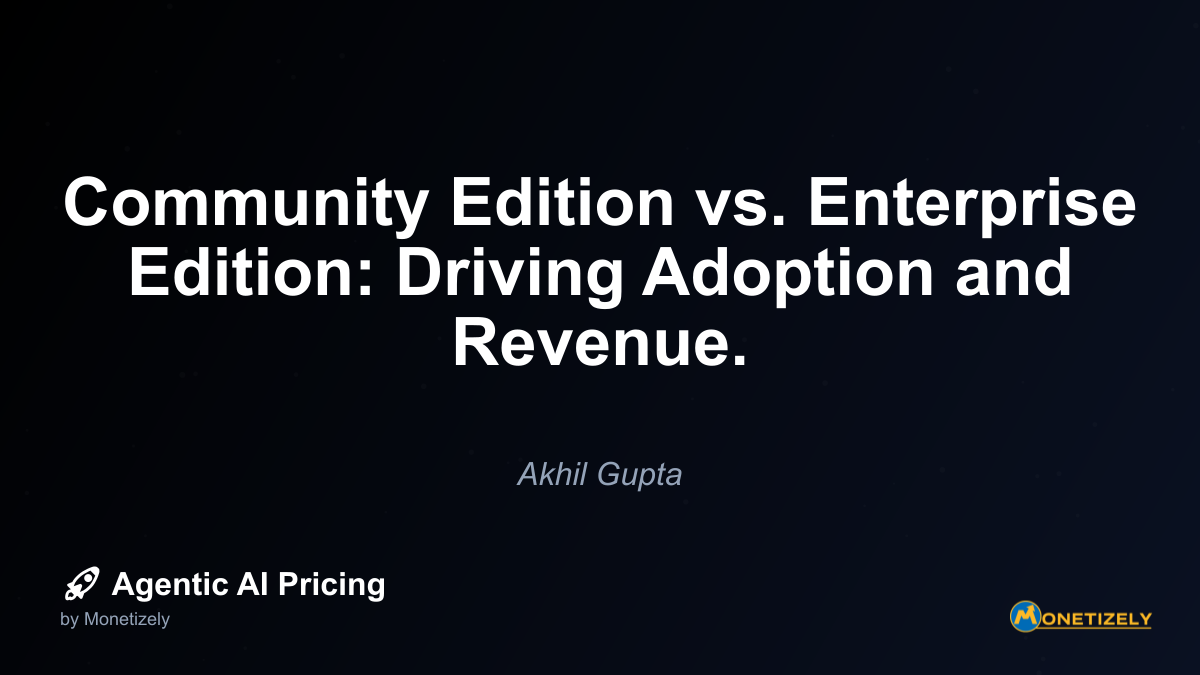· Akhil Gupta · Strategy & Planning · 9 min read
Bundling AI Software with Services: A Hybrid Approach.
AI and SaaS Pricing Masterclass
Learn the art of strategic pricing directly from industry experts. Our comprehensive course provides frameworks and methodologies for optimizing your pricing strategy in the evolving AI landscape. Earn a professional certification that can be imported directly to your LinkedIn profile.

Core Software with Service Add-Ons
Some AI providers prefer to keep their software and service components separate, allowing customers to purchase additional services as needed. This approach offers flexibility but may result in lower service adoption.
In this model, customers might purchase the core AI platform at a base price, then add service packages such as:
- Implementation package ($10,000 one-time fee)
- Custom model training ($5,000 per use case)
- Premium support ($1,500 per month)
- Quarterly business reviews ($2,500 per quarter)
This approach works well for customers with varying needs and budgets, though it can create more complex sales cycles and revenue forecasting challenges.
Consumption-Based Services
For AI solutions with variable usage patterns, some providers adopt a consumption-based approach for both software and services. For example:
- Base platform fee: $2,000 per month
- Per-transaction processing: $0.10 per document
- Service credits: Included 50 credits per month (additional credits at $200 each)
Service credits might be consumed for implementation support, custom training, or expert consultation, giving customers flexibility in how they utilize professional services.
Strategic Benefits of the Bundled Approach
Beyond the immediate revenue advantages, bundling AI software with services offers several strategic benefits for providers and customers alike.
Accelerating Customer Success
The primary benefit of bundling is dramatically improved customer outcomes. By providing the necessary expertise and support alongside powerful technology, bundled solutions address the full spectrum of implementation challenges. This comprehensive approach leads to:
- Faster time-to-value
- Higher user adoption rates
- More effective utilization of AI capabilities
- Stronger alignment with business objectives
These improved outcomes translate directly into higher customer satisfaction, stronger references, and increased retention rates.
Differentiating in a Crowded Market
As AI capabilities become increasingly commoditized, service quality offers a powerful differentiation strategy. While competitors might match feature sets, the human expertise and support that comes with bundled offerings is much harder to replicate.
This differentiation is particularly valuable in enterprise sales, where buyers are increasingly skeptical of technology promises and more focused on proven outcomes. A bundled approach signals confidence in the provider’s ability to deliver those outcomes, not just provide technology.
Building Deeper Customer Relationships
Service components create natural opportunities for ongoing customer engagement beyond technical support. Implementation consultants, trainers, and success managers develop relationships across the customer organization, providing valuable insights and identifying expansion opportunities.
These relationships transform the vendor-customer dynamic from transactional to consultative, positioning the AI provider as a strategic partner rather than just a technology supplier. This elevated position typically leads to:
- Longer contract terms
- Higher renewal rates
- Increased expansion revenue
- More strategic product feedback
- Stronger customer advocacy
Capturing Premium Pricing
Perhaps most importantly from a business perspective, bundled offerings command premium pricing compared to standalone software. This premium reflects the added value of services and the improved outcomes they enable.
For example, while standalone AI chatbot software might sell for $2,000 per month, a bundled solution including implementation, training, and optimization services might command $3,500 per month—a 75% premium that delivers substantially more value to customers and higher margins to providers.
Real-World Examples of Successful AI Bundling
Several leading AI companies have successfully implemented bundled approaches, demonstrating the effectiveness of this strategy across different market segments.
Enterprise AI Platforms
Major enterprise AI providers like Palantir and C3.ai have built their entire business models around bundled offerings. Rather than selling standalone software, they provide comprehensive solutions that include substantial professional services components.
Palantir’s approach is particularly instructive—their “Forward Deployed Engineers” work directly with customers to implement and optimize their AI platform. This high-touch model has enabled them to secure large, long-term contracts with government agencies and Fortune 500 companies, commanding premium prices that reflect the value of their combined software and expertise.
Vertical AI Solutions
In specialized industries like healthcare, finance, and legal services, AI providers are finding particular success with bundled approaches. These domains require deep industry knowledge alongside technical expertise, making services a critical component of successful implementations.
For example, an AI-powered legal document analysis platform might bundle:
- The core AI technology
- Legal-specific model training for particular practice areas
- Integration with popular legal document management systems
- Training for attorneys and paralegals
- Ongoing model refinement based on usage patterns
This comprehensive solution addresses the specific challenges of legal AI implementation, justifying premium pricing and building strong customer loyalty.
SMB-Focused AI
Even in the small and medium business (SMB) market, where budgets are more constrained, bundled approaches can be effective when properly scaled. Many SMB-focused AI providers offer “light-touch” service bundles that provide essential support without the cost of enterprise-level engagements.
For example, an AI-powered marketing platform might include:
- Self-service implementation with guided workflows
- Virtual training sessions for marketing teams
- Template libraries for common use cases
- Email-based support with 24-hour response times
- Monthly performance reports with optimization recommendations
This approach delivers the essential services SMBs need without the cost of high-touch consulting, making bundled solutions accessible at lower price points.
Implementation Challenges and Solutions
While bundling offers significant advantages, it also presents implementation challenges that organizations must address to be successful.
Scaling Service Delivery
Perhaps the most significant challenge in bundled approaches is scaling service delivery efficiently. Unlike software, which can be deployed to additional customers at minimal marginal cost, services require human resources that scale linearly with customer growth.
Successful AI companies address this challenge through several strategies:
- Tiered service models that reserve high-touch engagement for enterprise customers
- Productized services with standardized methodologies and deliverables
- Self-service components that reduce the need for direct consultant involvement
- Customer enablement programs that train internal champions
- Partner ecosystems that extend service delivery capacity
By combining these approaches, companies can maintain service quality while scaling their customer base.
Maintaining Margins
Services typically carry lower gross margins than software, potentially diluting the overall profitability of bundled offerings. To address this challenge, successful companies:
- Optimize service delivery efficiency through standardized methodologies
- Leverage technology to automate aspects of service delivery
- Develop junior-senior staffing models to optimize resource costs
- Price services at a premium when bundled with software
- Focus on high-value services that directly impact customer outcomes
These strategies help maintain healthy overall margins while delivering the service value customers expect.
Organizational Alignment
Bundled approaches require tight alignment between product and service teams, which can be challenging in organizations with traditional functional silos. Successful implementation requires:
- Unified leadership with accountability for overall solution success
- Integrated planning between product and service organizations
- Shared metrics that focus on customer outcomes rather than functional KPIs
- Cross-functional teams for implementation and customer success
- Feedback loops that incorporate service insights into product development
This alignment ensures that software and services evolve together to deliver maximum customer value.
Best Practices for Implementing Bundled AI Offerings
Based on the experiences of successful AI companies, several best practices emerge for organizations considering a bundled approach.
Start with Customer Outcomes
The most effective bundles are designed backward from desired customer outcomes rather than forward from existing capabilities. This outcome-focused approach ensures that both software and service components directly contribute to customer success.
For example, rather than simply bundling generic “implementation services” with an AI platform, successful providers identify specific outcomes (like “90% automation of invoice processing within 60 days”) and design service components specifically to achieve those outcomes.
Create Clear Value Propositions
Customers must clearly understand the value of bundled offerings compared to standalone alternatives. Effective value propositions articulate:
- Specific outcomes the bundle will deliver
- Time and resource savings compared to self-implementation
- Risk reduction through expert guidance
- Accelerated time-to-value
- Ongoing optimization benefits
These value propositions should be quantified whenever possible, helping customers justify the premium price of bundled offerings.
Design for Different Customer Segments
Different customer segments have varying service needs and budgets. Successful bundled approaches typically offer multiple options tailored to specific segments:
- Enterprise: High-touch, customized services with dedicated resources
- Mid-market: Standardized service packages with moderate customization
- SMB: Productized services with self-service components and group training
This segmented approach ensures that each customer receives appropriate service levels without over-delivering to price-sensitive segments or under-delivering to high-value customers.
Build Service Delivery Excellence
In bundled offerings, service quality becomes as important as product quality. Successful providers invest in:
- Rigorous consultant hiring and training
- Standardized methodologies and best practices
- Knowledge management systems
- Customer feedback mechanisms
- Continuous service improvement processes
These investments ensure consistent service delivery and protect the premium positioning of bundled offerings.
Measure and Communicate Value
To maintain premium pricing and high renewal rates, bundled AI providers must continuously measure and communicate the value they deliver. Effective approaches include:
- Regular business reviews highlighting achieved outcomes
- ROI calculations based on actual results
- Benchmark comparisons with industry standards
- Success stories from similar customers
- Documentation of avoided pitfalls and risks
This ongoing value communication reinforces the customer’s decision to purchase a bundled solution and builds the case for renewal and expansion.
The Future of AI Software-Service Bundles
As AI technology continues to evolve, bundled approaches are likely to become even more important in the market. Several trends are shaping the future of this strategy:
Increasing AI Complexity
As AI capabilities grow more sophisticated, the expertise required for successful implementation also increases. This complexity drives demand for bundled services that help customers navigate the challenges of advanced AI deployment.
Focus on Business Transformation
Organizations are increasingly viewing AI not just as technology but as a driver of business transformation. This broader perspective favors bundled approaches that address the organizational and process changes required for successful transformation, not just the technical implementation.
Hybrid Human-AI Solutions
Many AI applications are evolving toward hybrid models that combine AI automation with human expertise. These hybrid solutions naturally lend themselves to bundled approaches, with services providing the human component that complements the AI technology.
Outcome-Based Pricing
Some leading AI providers are moving toward outcome-based pricing models, where fees are tied directly to achieved results rather than software usage or service hours. This approach aligns provider and customer incentives while reinforcing the value of bundled solutions in delivering measurable outcomes.
Conclusion
Bundling AI software with professional services offers a compelling strategy for companies looking to differentiate their offerings, capture premium pricing, and ensure customer success. By combining powerful technology with essential expertise and support, bundled solutions address the full spectrum of implementation challenges and deliver superior outcomes compared to standalone software.
While implementing a bundled approach presents challenges in service scaling, margin management, and organizational alignment, companies that successfully navigate these challenges position themselves for sustainable competitive advantage in the rapidly evolving AI market.
For AI providers considering their pricing and packaging strategies, the bundled approach deserves serious consideration—not just as a revenue model, but as a comprehensive go-to-market strategy that puts customer success at the center of the business.
For customers evaluating AI solutions, bundled offerings often represent superior value despite their premium pricing, delivering faster time-to-value, reduced implementation risk, and better long-term outcomes compared to software-only alternatives.
As the AI market continues to mature, the companies that thrive will likely be those that master the art of bundling software and services into comprehensive solutions that deliver transformative business value.
Co-Founder & COO
Akhil is an Engineering leader with over 16+ years of experience in building, managing and scaling web-scale, high throughput enterprise applications and teams. He has worked with and led technology teams at FabAlley, BuildSupply and Healthians. He is a graduate from Delhi College of Engineering and UC Berkeley certified CTO.
Pricing Strategy Audit
Let our experts analyze your current pricing strategy and identify opportunities for improvement. Our data-driven assessment will help you unlock untapped revenue potential and optimize your AI pricing approach.




